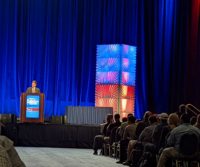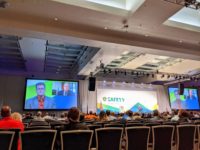At ASSP’s Safety 2023 event in San Antonio in early June, Doug Parker, Assistant Secretary of Labor for Occupational Safety and Health, discussed the current state of OSHA and answered questions from audience live as they came in via text.
“A critical part of my job and fundamental part of my job is to stay in communication with the health and safety community so that we're working together,” Parker said, explaining why he chose to take time out of his busy schedule to attend the show in person. The following are some takeaways of various topics he discussed with attendees.
DEI initiatives
“It's critical that we focus on equity and that… health and safety in the workplace is available to everyone, regardless of their background, their gender, their nationality, because far too often that simply isn't the case.”
Parker told the audience that he heard from many workers of color at a workers’ voice summit last fall, and a few stories of how workers were treated difference or not heard at work stuck with him.
He offered a few examples of inequity in the workplace, such as a woman who spoke of chemical exposure in the workplace related to her pregnancy complications, but the workplace never communicated the risk to her. Another story he mentioned was about an undocumented worker who burned his leg in a hot water spill who was told to stay at work. He ended up with gangrene and an amputation. HE didn’t speak up due to his undocumented status, Parker said.
“I'm the first to admit, as a former legal aid attorney, I confronted workers in that situation and said, I don't know how to help you, it's not my job, or there's nothing that we can do. And I realized that perhaps that was true, but I could have done much better.
“And if I had done a better job of listening, then we then we could have possibly found some solution. Thinking outside of my parameters about how we could actually help this worker and solve a problem.”
He closed with a call to everyone to change the traditional way of thinking that everyone is taught and open their ears to listen to workers who may not have the right resources.
“Find ways to find common ground and solutions and really hear what their concerns are, and take into account their circumstances,” he said.
Severe violators
Parker said OSHA has updated their Severe Violator Enforcement Program so it applies to all industries based on its management or disregard for health and safety, not just high-hazard.
“We took down that artificial barrier,” he said, “and the vast majority of companies still in the program are what we considered previously to be high hazard industries, but we thought that it was important to eliminate that barrier.”
He said OSHA also created a program for companies to get out of the severe violators program if they implement effective health and safety management systems.
He also said OSHA is strengthening their collaboration with the Solicitors’ Office for more strategic alignment.
“We are seeking broader settlements, but we are identifying business models that are having a negative impact on health and safety and trying to figure out how we can work through the settlement process and litigation to find lasting solutions to root causes.”
Heat safety
“The region saw record breaking heat events last year with temperatures at least 100 degrees for consecutive months. So last year, we launched a National Emphasis Program on heat that leads with outreach to make sure that employers and workers understand the hazard and understand the basic steps to take to prevent the illness.”
Parker said OSHA did more than 1,700 Heat National Emphasis Program inspections last year and will continue that program this year. He reminded everyone that risk factors start to present at much lower temperatures than people realize.




